February 2025
The global roofing materials market size is estimated at USD 144.97 billion in 2025 and is predicted to reach around USD 209.38 billion by 2034, accelerating at a CAGR of 4.13% from 2025 to 2034. The Asia Pacific roofing materials market size surpassed USD 47.84 billion in 2025 and is expanding at a CAGR of 4.28% during the forecast period. The market sizing and forecasts are revenue-based (USD Million/Billion), with 2024 as the base year.
The global roofing materials market size was estimated for USD 139.66 billion in 2024 and is anticipated to reach around USD 209.38 billion by 2034, growing at a CAGR of 4.13% from 2025 to 2034. Rising construction activities across the globe is expected to boost the growth of the roofing materials market.
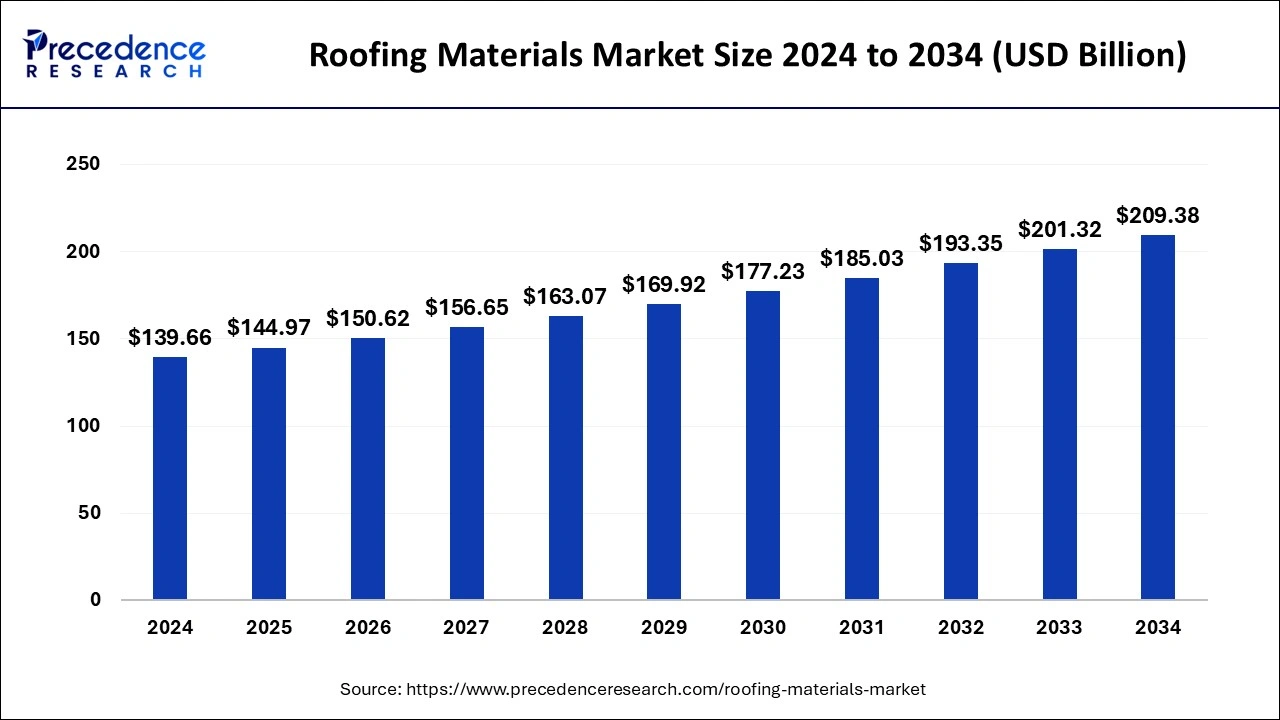
The integration of AI in the manufacturing processes of roofing materials helps in creating optimized roofing structures. It also helps in quality control, leading to the development of high-quality, durable roofing products that can meet stringent standards and withstand harsh conditions. AI can improve production efficiency through automation and reducing waste generation. In addition, AI-driven analytics help manufacturers forecast demand and manage inventory levels.
The Asia Pacific roofing materials market size was estimated at USD 46.09 billion in 2024 and is anticipated to be surpass around USD 70.14 billion by 2034, rising at a CAGR of 4.28% from 2025 to 2034.
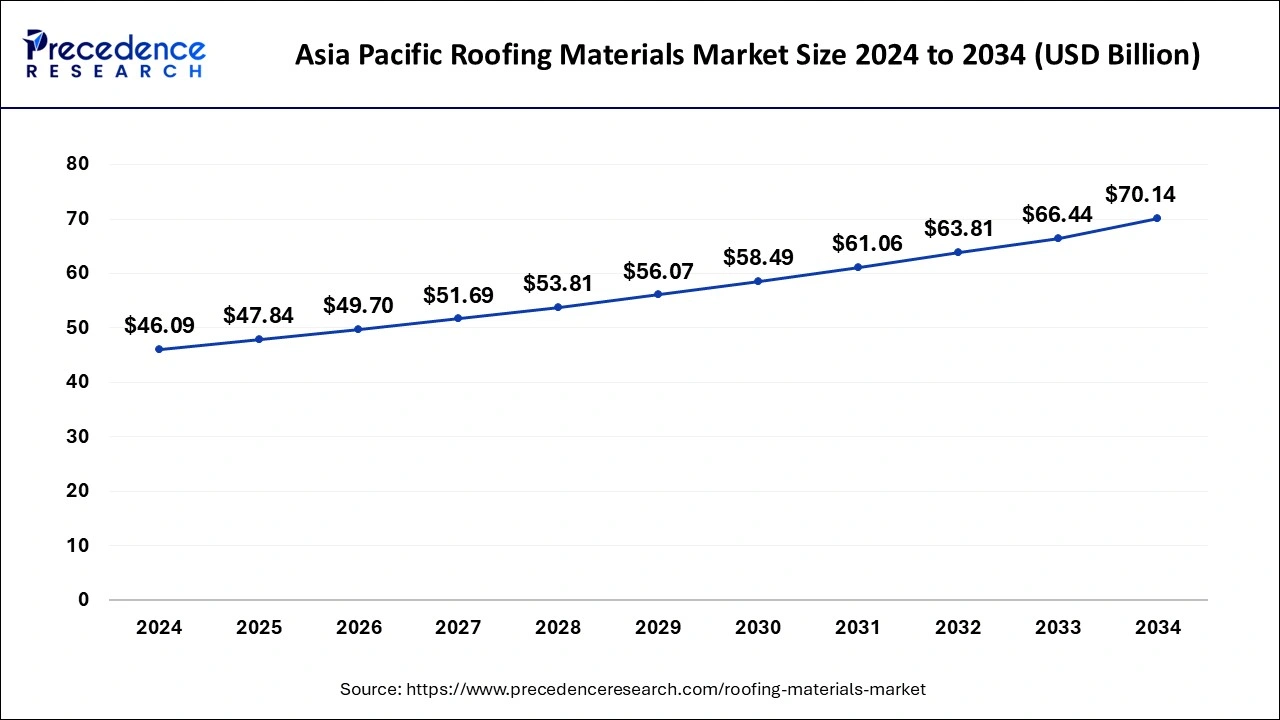
Asia Pacific dominated the global roofing materials market with the largest market share of 33% in 2024. This dominance is credited to strong profitable regional growth. In addition, presence of various manufacturers of the product along with the huge population of the region is boosting the growth of the product. Furthermore, this region comprise of more than55% of the global population along with production hub for automotive and electronics industry. Farther rising disposable income and growing domestic sector across Indonesia, China, India, and South Korea are fueling the industry growth.
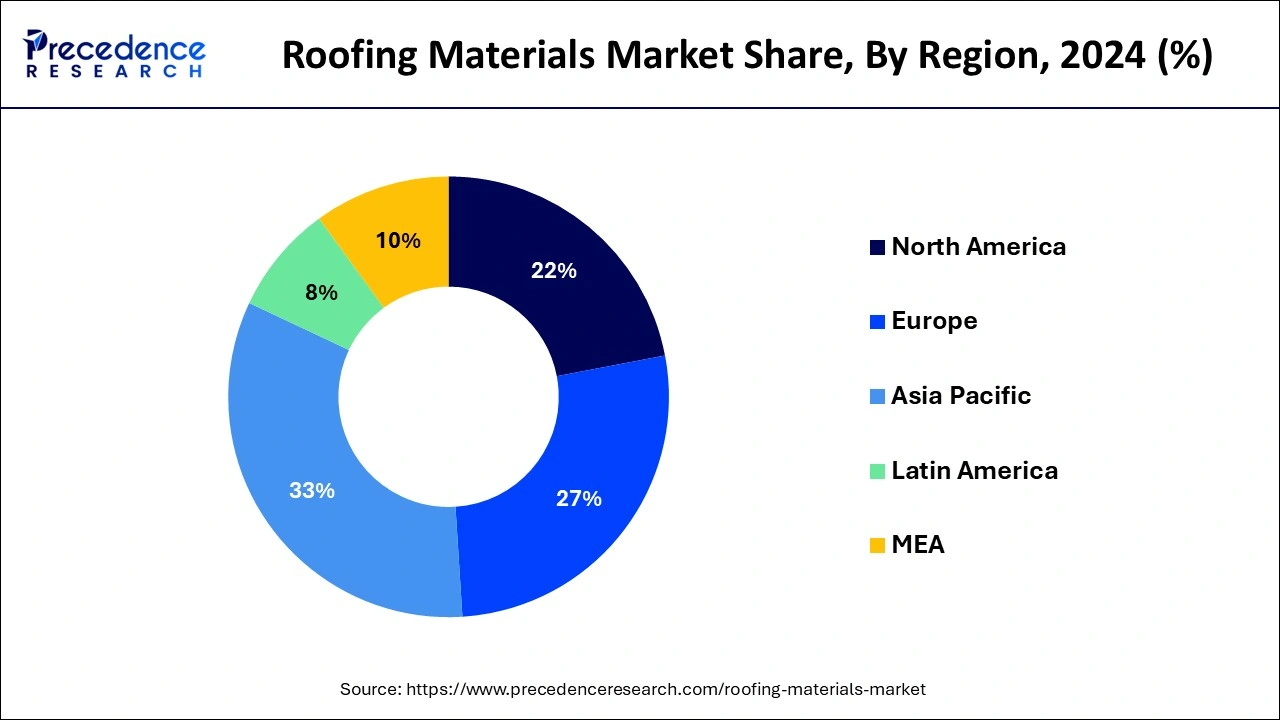
The roofing material demand in the region Asia Pacific is in line with the progress of the sector of construction, which comprise of home renovation and new construction conditioning. Rise in industrial operations, especially in India and China coupled with population expansion, has led to an increased demand for structure and construction activities, latterly driving the demand for roofing material.
In Middle East and Africa, the demand for roofing material is primarily driven by the rapid growth of the domestic construction sector in Kenya, Nigeria, Egypt, and Ethiopia. In addition, the constant construction smash in Qatar, Saudi Arabia, and UAE are producing high demand for the material of roofing.
Roofing material is material used in the furthermost layer on the roof of home or industrial or commercial space. A wide range of material used in the process is concrete & claytiles, bituminous, elastomers, Metal and plastics, among others. The material offers a wide range of advantages to the structure including water proofing and temperature control. Rising disposable income, increased affordability and easy availability of loans have led homeowners to spend further on home refurbishment and renovation. The rising consumer interest regarding home renovation and enhancing the aesthetics of structures of living provided myriad opportunities for rising products sales. Likewise, strict energy-effective home regulations and growing interest of customers in green buildings will support the penetration of product during the forecast forthcoming time period.
In addition, the emergence of reflective coatings techniques which is further applied over a dark-colored roofing materials is likely to have a positive impact over the market. In addition, reflective coatings show the property of superior heat reflection and it also reduce the overall consumption of energy of the building structure. Superior aesthetics, durability, and installation ease associated with these products are projected to propel the demand for the product. In addition, the usage of 3D printing technology in order to produce numerous roofing structural components systems is likely to boost the demand for roofing materials during the forecast period.
| Report Coverage | Details |
| Market Size in 2025 | USD 144.97 Billion |
| Market Size by 2034 | USD 209.38 Billion |
| Growth Rate from 2025 to 2034 | CAGR of 4.13% |
| Base Year | 2024 |
| Largest Market | Asia Pacific |
| Forecast Period | 2025 to 2034 |
| Segments Covered | Type, Application, Construction, Region |
| Regions Covered | North America, Europe, Asia-Pacific, Latin America, and Middle East & Africa |
The concrete and clay tiles segment accounted for the highest market share of 32% in 2024. These tiles offer advantages similar as superior aesthetics, durability, versatility, and ease of recycling, and hence drive product demand.
The asphalt shingles segment is expected to grow at a CAGR of 4% during the forecast period. In addition, properties similar as cost- effectiveness, ease of installation, and longer lifetime are anticipated to drive the demand for the product. In addition, it provides water-and algae-resistant parcels with superior quality, which is likely to further boost the segment growth.
In 2024, the segment named metal roof accounted for a share of more than 20% of the market. In addition, metal roofs exhibit superior quality of durability and fire resistance, which is estimated to fuel its demand in new activities of construction. Likewise, the adoption of Metal roofing in artificial operations on account of advantages similar as easy installation is anticipated to drive the segment growth.
The plastic roofs segment is anticipated to register significant CAGR during the forecast period owing to advantages similar as low conservation and ease of installation.
The residential segment contributed the highest market share of 58% in 2024. Growing institutional and governmental support for the housing development structure in arising economies is the factor propelling the demand for roofing material for domestic purposes. Furthermore, the crucial factors driving the demand for roofing material for domestic operations include adding population and growing preference for single- family housing structures. Likewise, the easy availability of low- interest rates and credits plays an essential part in the overall demand for residential buildings.
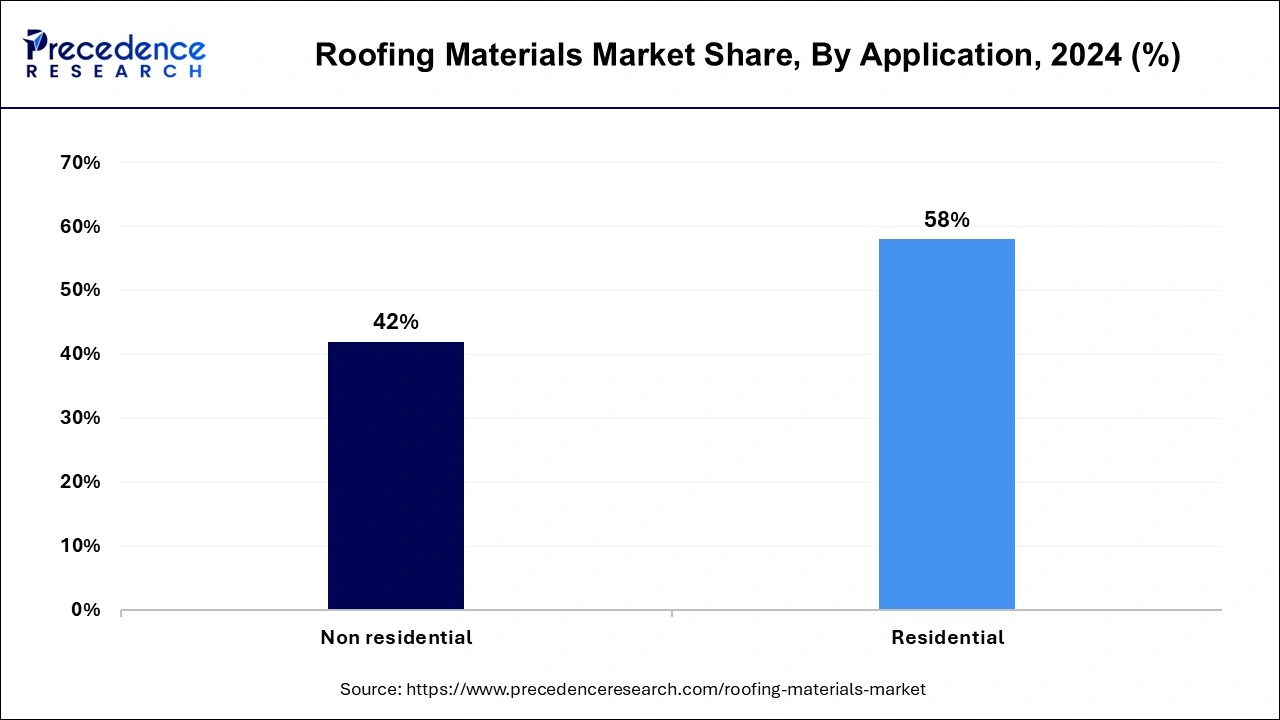
Upsurge in investments for the construction and renovation of social architectures, similar as hospitals, educational buildings, government services, and correction installations is anticipated to drive the demand for roofing material for non-residential application.
Likewise, the surge in popularity of online shopping is anticipated to boost the growth of marketable construction units similar as sorting installations, storages, and distribution centers. Growing investments in the development of data centers by major technology enterprises similar as Microsoft, Google, and Amazon is also projected to positively impact the implicit demand for roofing material.
The roofing material market is highly fragmented with the presence of several local and global companies. These market players are striving to gain higher market share by adopting strategies, such as investments, partnerships, and acquisitions & mergers. Companies are also spending on the development of improved products. Moreover, they are also focusing on maintaining competitive pricing.
Key players operating in the market are majorly focusing towards increasing their market share by offering a varied range of easy, durable and quick to install roofing materials. Moreover, these key players have further developed an extensive authorized roofing contractor’s network in order to ensure the roof installation quality in order to increase their customer base. Also, the key market players include in the study of roofing material market are Boral Ltd., GAF Materials Corporation, BraasMonier Building Group, Atlas Roofing Corporation, Owens Corning, Carlisle Companies Inc. and Johns Manvill.
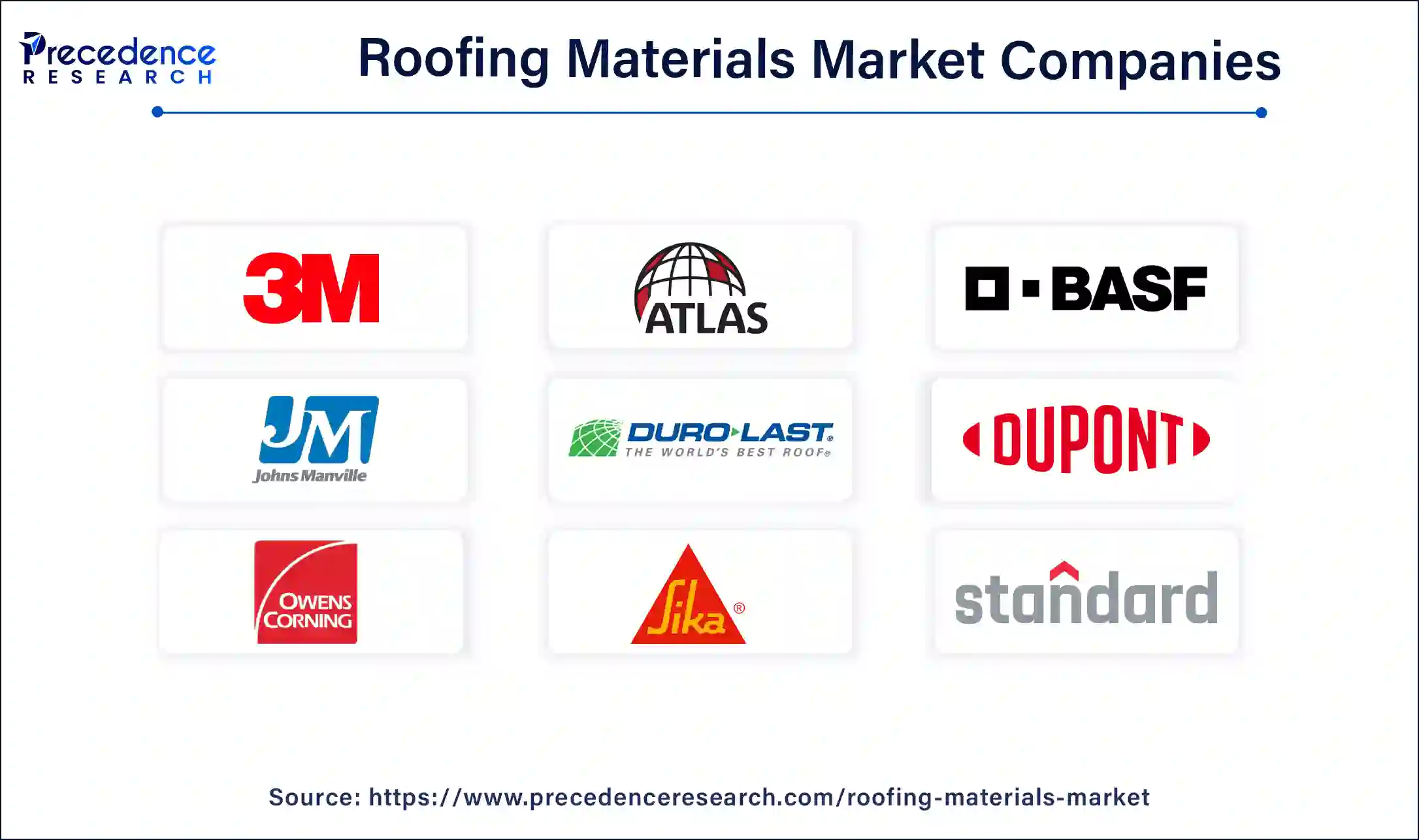
By Product
By Application
By Construction
By Geography
For inquiries regarding discounts, bulk purchases, or customization requests, please contact us at sales@precedenceresearch.com
No cookie-cutter, only authentic analysis – take the 1st step to become a Precedence Research client
February 2025
February 2024
January 2025
September 2024